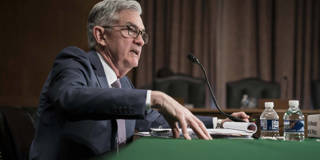Only monetary policy addresses credit throughout the economy. Until inflation and real interest rates rise from the grave, only a policy of effective deep negative interest rates, backed up by measures to prevent cash hoarding by financial firms, can do the job.
CAMBRIDGE – For those who viewed negative interest rates as a bridge too far for central banks, it might be time to think again. Right now, in the United States, the Federal Reserve – supported both implicitly and explicitly by the Treasury – is on track to backstop virtually every private, state, and city credit in the economy. Many other governments have felt compelled to take similar steps. A once-in-a-century (we hope) crisis calls for massive government intervention, but does that have to mean dispensing with market-based allocation mechanisms?
Blanket debt guarantees are a great device if one believes that recent market stress was just a short-term liquidity crunch, soon to be alleviated by a strong sustained post-COVID-19 recovery. But what if the rapid recovery fails to materialize? What if, as one suspects, it takes years for the US and global economy to claw back to 2019 levels? If so, there is little hope that all businesses will remain viable, or that every state and local government will remain solvent.
A better bet is that nothing will be the same. Wealth will be destroyed on a catastrophic scale, and policymakers will need to find a way to ensure that, at least in some cases, creditors take part of the hit, a process that will play out over years of negotiation and litigation. For bankruptcy lawyers and lobbyists, it will be a bonanza, part of which will come from pressing taxpayers to honor bailout guarantees. Such a scenario would be an unholy mess.

CAMBRIDGE – For those who viewed negative interest rates as a bridge too far for central banks, it might be time to think again. Right now, in the United States, the Federal Reserve – supported both implicitly and explicitly by the Treasury – is on track to backstop virtually every private, state, and city credit in the economy. Many other governments have felt compelled to take similar steps. A once-in-a-century (we hope) crisis calls for massive government intervention, but does that have to mean dispensing with market-based allocation mechanisms?
Blanket debt guarantees are a great device if one believes that recent market stress was just a short-term liquidity crunch, soon to be alleviated by a strong sustained post-COVID-19 recovery. But what if the rapid recovery fails to materialize? What if, as one suspects, it takes years for the US and global economy to claw back to 2019 levels? If so, there is little hope that all businesses will remain viable, or that every state and local government will remain solvent.
A better bet is that nothing will be the same. Wealth will be destroyed on a catastrophic scale, and policymakers will need to find a way to ensure that, at least in some cases, creditors take part of the hit, a process that will play out over years of negotiation and litigation. For bankruptcy lawyers and lobbyists, it will be a bonanza, part of which will come from pressing taxpayers to honor bailout guarantees. Such a scenario would be an unholy mess.